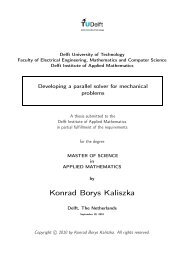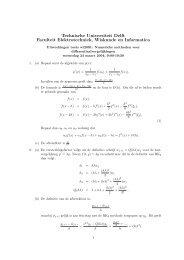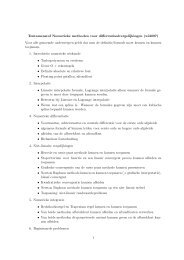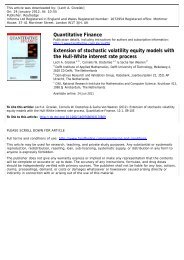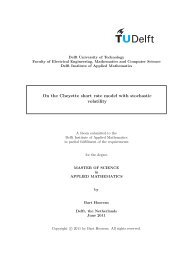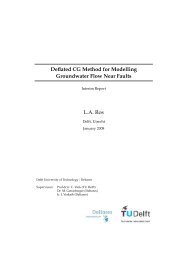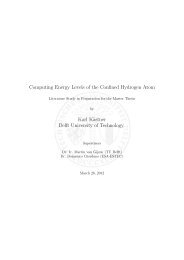AN EVALUATION OF PARALLEL MULTIGRID AS A SOLVER AND A ...
AN EVALUATION OF PARALLEL MULTIGRID AS A SOLVER AND A ...
AN EVALUATION OF PARALLEL MULTIGRID AS A SOLVER AND A ...
You also want an ePaper? Increase the reach of your titles
YUMPU automatically turns print PDFs into web optimized ePapers that Google loves.
<strong>MULTIGRID</strong> <strong>AS</strong> A <strong>SOLVER</strong> <strong>AN</strong>D A PRECONDITIONER 93(2j+1)J+1w3Xw4= coarse (and fine) grid point(2j)X X XX= fine grid point(2j-1)Jw1w2XI I+1(2i-1) (2i) (2i+1)FIG. 3. One coarse grid cell with the prolongation weights and four fine grid cells for standardmultigrid (for coarse grid indices capital letters are used and the fine grid indices are in brackets).The three multigrid preconditioners that are implemented and whose performance iscompared are now discussed.2.2.1. Prolongation operators. In the first two algorithms different matrixdependentprolongation operators are implemented. Figure 3 shows one coarse andfour fine grid cells with indices for the explanation of the different prolongationweights. The first operator is well known in the literature ([3], [6]) and has beenused before by the authors in [23]. Problems on grids with arbitrary grid sizes can besolved with a similar efficiency. So it is not necessary to choose powers of two (+1)for the grid sizes. The prolongation mapping P L+1 : u L ∈ Q GL ↦→ u L+1 ∈ Q GL+1with weights w1, w2, and w3 appears as follows:• for (2i, 2j − 1) ∈ Q GL+1d 1 = a 1 2i,2j−1 + a4 2i,2j−1 + a7 2i,2j−1 ,d 2 = a 3 2i,2j−1 + a6 2i,2j−1 + a9 2i,2j−1 ,d = −(a 2 2i,2j−1 + a5 2i,2j−1 + a8 2i,2j−1 ),w1 2i,2j−1 = d1d ; w2 2i,2j−1 = d2d ;• for (2i − 1, 2j) ∈ Q GL+1d 1 = a 1 2i−1,2j + a2 2i−1,2j + a3 2i−1,2j ,d 2 = a 7 2i−1,2j + a8 2i−1,2j + a9 2i−1,2j ,d = −(a 4 2i−1,2j + a5 2i−1,2j + a6 2i−1,2j ),w1 2i−1,2j = d1d ; w3 2i−1,2j = d2d .The construction of d differs from the operators in [23] and results in an accurateprolongation, for example, near Dirichlet boundaries, when the grid size is not idealfor multigrid.On the remaining points the prolongation is found as follows:(21)(22)on points (2i-1,2j-1) u L+12i−1,2j−1 = uL i,j;on points (2i,2j) u L+12i,2j is determined so that AL+1 P L+1 u L = 0 at (2i,2j).Some matrix components in the algorithm disappear at boundaries. Therefore, theprolongation is also valid at a boundary. This first algorithm is denoted by MG1.




